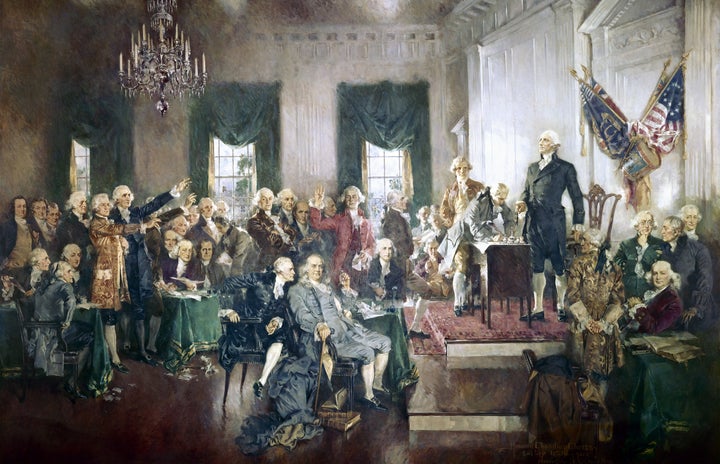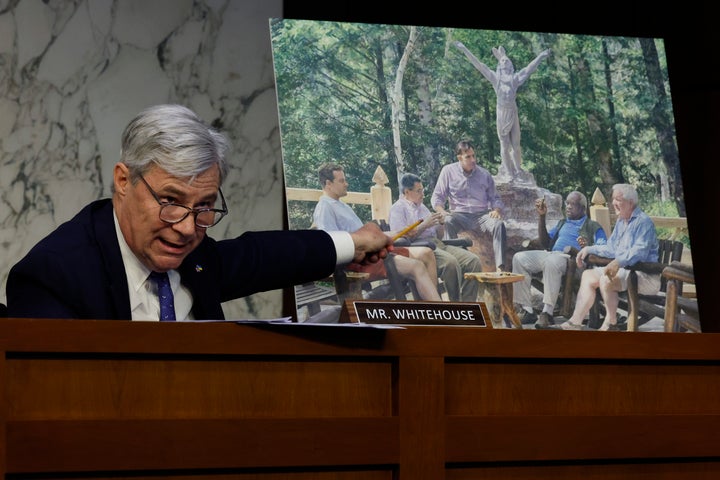Supreme Court Justice Clarence Thomas’ relationship with conservative billionaire Harlan Crow is corrupt.
No, there’s no evidence yet Thomas changed his views to fit what his benefactor wants, at least not yet. There is, however, no need to require a quid pro quo to prove corruption under Thomas’ favorite form of legal interpretation: originalism.
“Words have meaning at the time they are written. When we read something that someone else has written, we give the words and phrases used by that person natural meaning in context,” Thomas said at a conference on originalism in 2019.
In the past month, Thomas has been revealed to have hidden hundreds of thousands of dollars in private jet and yacht travel, luxury vacations and lodging, the sale of a family property and the payment of his adopted son’s boarding school tuition, all in connection with Crow. His wife, Ginni Thomas, also reportedly received secret payments from Leonard Leo, the mastermind of the conservative takeover of the court.
Thomas’ failure to properly disclose the gifts and sales he made in connection with Crow may be illegal under the Ethics in Government Act. That would be for the Department of Justice and the courts to decide. But it is clear that Thomas’ relationship with the billionaire Crow, and the conservative judicial establishment connected to Crow, is corrupt under the original meaning of corruption at the founding.
(Perhaps, the original meaning of corruption has no bearing here. Times have changed. Our conception of corruption shifted with the discovery that business could corrupt politics, too. The philosophies that influenced the founders no longer hold sway. Take it up with Thomas and the originalists who selectively choose which original meanings matter and which don’t.)
Corruption, at the founding, did not mean what Thomas and his colleagues on the court say it does now: strict quid pro quo corruption ― you do this in exchange for that. According to historian Gordon Wood, the framers saw corruption as a “technical term of political science” rooted in the writings of classical republican theory from ancient Greece and Rome, and in more modern adaptations like those of the philosophers Montesquieu and Machiavelli.

This idea of corruption was systemic in nature and emerged in revolutionary America from experiences with the British monarchy and its abuses of power. Classical republicans saw corruption as the undermining of virtue and a direct threat to a republican government through external dependence and the use of office for personal interest.
“When the delegates spoke of corruption at the convention they did so in a manner that reflected classical republican concerns about dependency, cabals, patronage, unwarranted influence, and bribery,” James Savage, a University of Virginia political scientist, wrote in his 1994 paper “Corruption and Virtue at the Constitutional Convention.”
Dependence meant the improper influence of an external force over a body of government. As the framers constructed a balanced system of government, they were explicitly concerned about the unbalanced dependence of one branch of government on another. They witnessed the British king bend Parliament to his will by handing out offices, titles and gifts, and sought to restrain executive power as a result.
“A citizen who took bribes from men in power was not only corrupt in the common sense of the word, but corrupt in the classical; he was liable to become dependent on that source of supply and, like the soldiers of the late Roman Republic, to degenerate from a citizen into a client,” political historian J.G.A. Pocock wrote in his essay “Civic Humanism and Its Role in Anglo-American Thought.”
Officials who take the path of corruption are “tempted by narcissism, ambition, or luxury, to place private gain before public good in their public actions,” Fordham School of Law professor Zephyr Teachout wrote in “The Anti-Corruption Principle.”
The Constitution was constructed with these fears about corruption, and how to avoid it, in mind. The government is therefore split into three branches, with separation of powers and checks and balances, so that no one branch can become too dependent on another. Multiple officeholding is banned so that the executive cannot act like the king and use appointments to create dependencies. Foreign emoluments to officeholders were banned. And so on.
The framers spent little time discussing the creation of the judiciary, and therefore judicial corruption received little attention. They had other concerns on their minds.
“Corrupt judges had not been on the revolutionists’ mind; corruption by the executive had,” John Noonan, the late appeals court judge, wrote in his intellectual and legal history of bribery. But they still discussed and implemented constitutional provisions to guard against the judiciary developing an improper dependence on the other two branches, or on the “gust of faction,” as one delegate called it.

Supreme Court justices were given life tenure to insulate them from politics and the factions politics creates. Their pay was fixed and could not be reduced by Congress, in order to prevent a dependency if the legislative branch were to object to their rulings. They could serve during “good behavior,” a sign that they should not be corrupt.
This original conception of “dependence corruption” has been theorized in recent years by legal scholars like Teachout and Harvard Law School professor Lawrence Lessig in arguments about federal campaign finance law. A number of conservative lawyers have not challenged the veracity of this original meaning of corruption, but rather stated that it is no longer relevant.
Lessig and Teachout’s revival of the original conception of dependence corruption focused largely on the elected branches of government, in particular the House of Representatives, as the framers said it should be “dependent on the people alone.” But concerns about dependence may go even further for the Supreme Court.
The justices are not meant to be dependent on the people, but they are expected to be the most disinterested and most independent of all of the constitutional officers across the government. This concept of judicial independence, and the measures adopted over the years to protect it, has led to strict rules for recusal, conflict of interest and disclosure for all judges, save those on the Supreme Court.
Thomas has flouted all of these rules for decades as he’s hidden his dependence on the billionaire Crow and his wife’s dependence on payouts from a litany of conservative activist organizations, including Leo’s court-focused groups. In doing so, he has become dependent on a political faction that is involved in the very intrigue and cabal the founders worried themselves about.
Crow isn’t any old rich man. He’s a funder of conservative politics who sits on the boards of conservative think tanks and political organizations. And more importantly, he is connected to the leading lights of the conservative legal movement that has spent large resources to take over the court. The painting hanging in his house does not just feature him enjoying a summer day with Thomas, but also with Leonard Leo, the longtime vice president of the conservative Federalist Society and the operator of the dark-money network used to identify, select and shepherd conservative judicial nominees onto the court. Leo sits atop a war chest of $1.6 billion designed to influence the court in favor of conservatives.
By taking money from Crow for luxury vacations and private schools while his wife took under-the-table payments from Leo, Thomas enmeshed himself in a political faction funded largely by undisclosed donors seeking to control the body where he holds office.
Whether or not Thomas and Crow are friends doesn’t matter here. There’s no reason to doubt that, but corruption can emerge out of friendship and vice versa. Indeed, Crow became friends with Thomas when Thomas was a justice and could not answer whether they would have become friends otherwise.
“It’s an interesting, good question,” Crow told The Dallas Morning News when asked if he would be friends with Thomas if he weren’t a Supreme Court justice. “I don’t know how to answer that. Maybe not. Maybe yes. I don’t know.”

The Supreme Court is supposed to be bound by rules to protect both against the dependence of justices on the other branches of government and against outside influence and the appearance of such. But Thomas chose not to follow the rules and disclose his dependence on someone connected to the effort to take control of the court for conservatives, just as he previously failed to disclose his wife’s income from conservative activist groups.
This corruption stains not just Thomas, but the whole court. When the framers worried about corruption they agreed that smaller institutions were more prone to corruption than larger ones, because one corrupt member of a small body could more easily corrupt the whole. Made up of just nine justices, the Supreme Court is far smaller than the House or Senate. And Chief Justice John Roberts has done little to nothing in response to Thomas’ flouting of the rules.
It’s not as though Thomas isn’t aware that justices should not be entwined in the secret political intrigue of factions. He’s said as much himself.
“The bitterness and enmity surrounding nominations to the federal bench have proven to be one of the principle [sic] modern threats to judicial independence,” Thomas told a gathering of the Federalist Society in 1999, according to a transcript. “Interest groups have turned the judicial appointments process into merely another theatre of operations for their unending battles. By making examples of nominees with whom they disagree, interest groups can seek to pressure potential or future nominees to adhere to certain positions and eschew others.”
Thomas’ speech focused on the then-recent adoption of liberal policies by the American Bar Association. Conservatives rejected the ABA’s role in the judicial nomination process ― it rates judges as qualified or not qualified ― in the 1980s. At the same time, conservatives founded the Federalist Society to act as a recruiter, trainer and filter for conservative judicial views in opposition to the ABA.
“Rather than worry about whether judges, secure in lifetime appointments and irreducible salaries, are the subject of too much popular criticism, the bar should seek to do its best to de-politicize the selection and nomination process of judges,” Thomas said. “We should not allow interest groups to undermine the very neutrality that is at the real heart of what it means to be a judge. Only by standing up to these pressures can we all really defend judicial independence.”
The Federalist Society came in for praise from Thomas for its “wall of separation between law and politics.”
That wall of separation may have been conceivable in 1999, but such comments are risible in 2023. Leo, the Federalist Society executive and today the co-chairman of its board of directors, helped shepherd the nominations of Roberts and Justice Samuel Alito in 2005. He worked with Sen. Mitch McConnell (R-Ky.) to block President Barack Obama’s nomination of Merrick Garland. Then he went to work for President Donald Trump to help him select Supreme Court justices and get them through the Senate.
Throughout all of this, Leo and Crow, and the activist groups tied to them, lavished Thomas with money and praise. What they have done is the flip side of Thomas’ worries about the politicization of the nomination process through negative attacks. They have rewarded him with gifts, family support, employment for his wife and the luxury life of a billionaire. This, too, is a threat to judicial independence and a fount of the original meaning of corruption.

